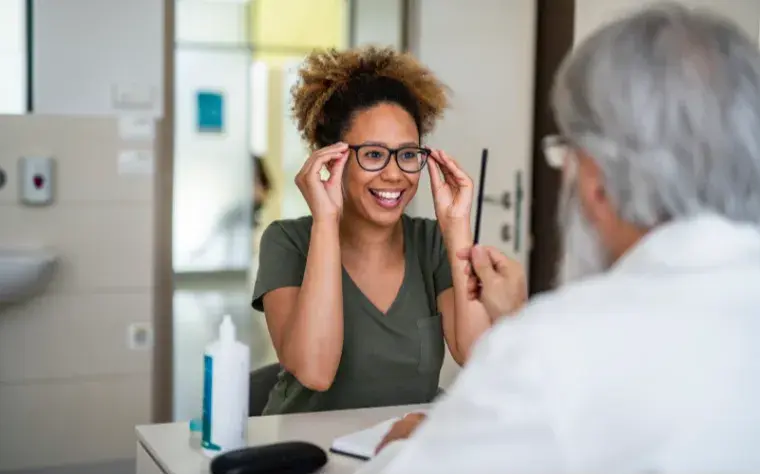
What does it mean to have 20/20 vision?
About one-third of Americans have 20/20 vision. The term “20/20 vision” comes from a system of measurement eye care providers use to evaluate how your vision compares to the average person's. They determine this by having you stand 20 feet away from an eye chart and reading aloud the letters that appear on different lines of the chart. This measures your visual acuity.
If you stand 20 feet from an eye chart and read the line of letters that people with average vision can see clearly from that same distance, you have 20/20 vision. The numbers simply mean that from 20 feet away, you can see just as clearly as the average person.
When does someone not have 20/20 vision?
When someone can't see things as sharply as someone with 20/20 vision, they may learn that they have 20/40 vision or 20/100 vision. That means the smallest letters they can clearly decipher from 20 feet away are the same as what an average person can clearly decipher from 40 or 100 feet away. People with 20/40 or 20/100 vision may experience refractive errors and can't see things in the distance as sharply as people with 20/20 vision can. The easiest way to find out is to have your eye care provider test you with a Snellen eye chart. Eye charts measure the sharpness of your vision by testing your visual acuity from different distances. You can even have different vision scores for each eye! When this happens, your depth perception and hand-eye coordination may be impaired.
For more information, schedule an appointment with Clarkson Eyecare.
Does 20/20 vision mean perfect vision?
You may be disappointed to hear that having 20/20 vision doesn't give you the license to brag about having stellar eyesight. It just means that you can see as well as the average person who doesn't need to wear glasses or contact lenses.
Some people actually have better-than-20/20 vision. People with 20/15 vision can see things clearly from 20 feet away that the average person can't see clearly unless they stand 15 feet away. Similarly, an even smaller percentage of people have 20/10 vision and can see what the average person would have to stand 10 feet away to see.
People with 20/20 vision need glasses, too!
Some people with 20/20 vision (or even 20/10 vision) may still need to wear glasses or contact lenses. That's because a 20/20 measurement needs to take into account things like whether you can discern colors properly or how well your peripheral vision and depth perception work. A simple eye chart test can't measure depth perception or if the shape of your eye affects your ability to see clearly.
Your eye health is more than a number.
Even if you have 20/20 vision, you’ll still want to get regular checkups to ensure your eyes are healthy and sharp. For example, some people with 20/20 vision can see well at a distance but struggle to view things close-up. Objects directly in front of them may appear blurry or out of focus. These people are farsighted and may need to wear glasses to read, sew or do other close-up activities. Age can also impact your vision. After the age of 40, many people can't focus well on close-up items that they used to be able to see clearly. They may need to wear reading glasses due to age-related vision changes despite otherwise having 20/20 vision.
Finally, there are people with 20/20 vision who have astigmatism and blurry vision as a result of an irregular eye shape. These people may also need to wear glasses or contact lenses to improve blurry vision.
Remember, your vision is so much more than a couple of numbers!
Achieving 20/20 Vision with Corrective Lenses
If you don't have 20/20 vision, wearing glasses or contact lenses will help you get there. About 75 percent of people who wear corrective lenses can achieve a 20/20 result by retaking the vision test with their glasses on or their contact lenses in.
Some people may not reach 20/20 vision while wearing corrective lenses, but glasses or contacts can still help enhance their vision. Even if corrective lenses don't get your vision to 20/20, it's important to know how well you score. To safely operate a motor vehicle, you are required to score 20/40 or better on a Snellen eye chart test while wearing glasses or contacts. If you get lower than that, you may not be able to get a driver's license. If you score 20/200 with corrective lenses, you're considered legally blind.
20/20 vision doesn't translate to "perfect" vision by any means, but it does denote strong visual acuity at a distance. A check-up with your eye doctor can help you determine if you have 20/20 vision and, if not, whether corrective lenses can help you reach it.
Schedule an appointment with Clarkson Eyecare today for healthier eyes.